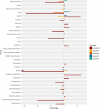The Baltic Sea Atlantis: An integrated end-to-end modelling framework evaluating ecosystem-wide effects of human-induced pressures
- PMID: 30028849
- PMCID: PMC6054375
- DOI: 10.1371/journal.pone.0199168
The Baltic Sea Atlantis: An integrated end-to-end modelling framework evaluating ecosystem-wide effects of human-induced pressures
Abstract
Achieving good environmental status in the Baltic Sea region requires decision support tools which are based on scientific knowledge across multiple disciplines. Such tools should integrate the complexity of the ecosystem and enable exploration of different natural and anthropogenic pressures such as climate change, eutrophication and fishing pressures in order to compare alternative management strategies. We present a new framework, with a Baltic implementation of the spatially-explicit end-to-end Atlantis ecosystem model linked to two external models, to explore the different pressures on the marine ecosystem. The HBM-ERGOM initializes the Atlantis model with high-resolution physical-chemical-biological and hydrodynamic information while the FISHRENT model analyses the fisheries economics of the output of commercial fish biomass for the Atlantis terminal projection year. The Baltic Atlantis model composes 29 sub-areas, 9 vertical layers and 30 biological functional groups. The balanced calibration provides realistic levels of biomass for, among others, known stock sizes of top predators and of key fish species. Furthermore, it gives realistic levels of phytoplankton biomass and shows reasonable diet compositions and geographical distribution patterns for the functional groups. By simulating several scenarios of nutrient load reductions on the ecosystem and testing sensitivity to different fishing pressures, we show that the model is sensitive to those changes and capable of evaluating the impacts on different trophic levels, fish stocks, and fisheries associated with changed benthic oxygen conditions. We conclude that the Baltic Atlantis forms an initial basis for strategic management evaluation suited for conducting medium to long term ecosystem assessments which are of importance for a number of pan-Baltic stakeholders in relation to anthropogenic pressures such as eutrophication, climate change and fishing pressure, as well as changed biological interactions between functional groups.
Conflict of interest statement
The authors have declared that no competing interests exist.
Figures












References
-
- Murawski S, Steele J, Taylor P, Fogarty M, Sissenwine M, Ford M, et al. Why compare marine ecosystems?. ICES Journal of Marine Science. 2009; 67(1): 1–9. doi: 10.1093/icesjms/fsp221 - DOI
-
- Ramos J, Soma K, Bergh O, Schulze T, Gimpel A, Stelzenmuller V, et al. Multiple interests across European coastal waters: the importance of a common language. ICES Journal of Marine Science. 2014; 72(2): 720–731. doi: 10.1093/icesjms/fsu095 - DOI
-
- Soma K, Ramos J, Bergh Ø, Schulze T, van Oostenbrugge H, van Duijn AP, et al. The “mapping out” approach: effectiveness of marine spatial management options in European coastal waters. ICES Journal of Marine Science. 2013; 71(9): 2630–2642. doi: 10.1093/icesjms/fst193 - DOI
-
- UNEP. Lääne A, Kraav E, Titova G. Baltic Sea, GIWA Regional assessment 17. University of Kalmar, Kalmar, Sweden; 2005.
Publication types
MeSH terms
LinkOut - more resources
Full Text Sources
Other Literature Sources

